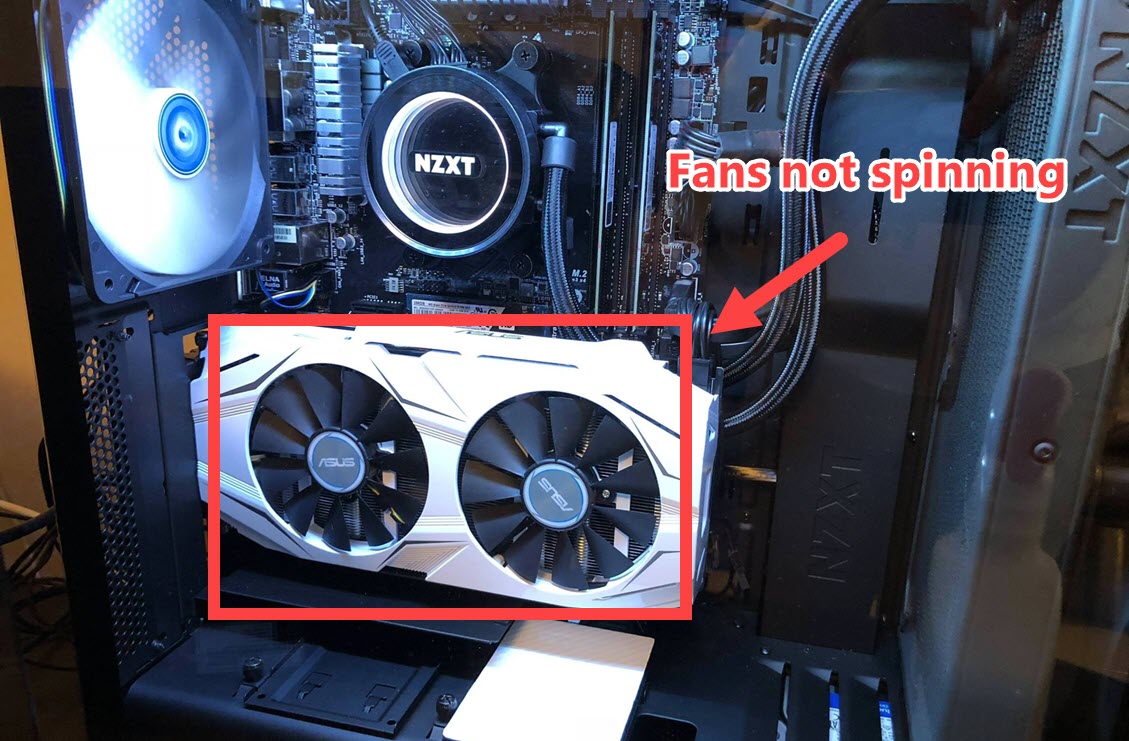Your GPU fans may not be spinning due to a loose connection or a malfunctioning fan. When your GPU fans fail to spin, it can lead to overheating and reduced performance.
Understanding the common causes behind this issue can help you troubleshoot your system effectively. In this guide, we will explore various reasons why your GPU fans may not be functioning and provide practical solutions to resolve the problem. By following these steps, you can ensure optimal airflow and cooling for your graphics card, improving its overall lifespan and performance.
Let’s dive into the troubleshooting process to get your GPU fans spinning again efficiently.

Credit: www.reddit.com
Common Causes Of Gpu Fan Not Spinning
When your GPU fans are not spinning, it can be a cause for concern as it may lead to overheating and performance issues. Here are some common reasons why your GPU fan may not be spinning:
A common cause of GPU fan not spinning is faulty connections. Check the fan connections to the graphics card to ensure they are secure. Loose or damaged connections can prevent the fans from receiving power, leading to malfunction.
If the GPU temperature is below a certain threshold, the fans may not spin. Monitor the GPU temperature using software and ensure it is within the operating range. Some GPUs have a passive cooling mode where fans don’t spin until the temperature reaches a certain level.
Incorrect fan control settings can also lead to the fans not spinning. Check the fan control settings in the graphics card software. Ensure that the fan speed is set to automatic or a suitable manual setting to prevent the fans from remaining idle.
Insufficient power from the PSU or a faulty power connector can cause the GPU fans to not spin. Check the power supply unit and ensure it is providing adequate power to the graphics card. Also, inspect the power connectors for any damage or loose connections.

Credit: www.reddit.com
Troubleshooting Steps For Gpu Fan Not Spinning
Here are the troubleshooting steps if your GPU fans are not spinning.
Ensure the GPU fans are properly connected to the motherboard.
Check the GPU temperature using software like MSI Afterburner.
Modify the fan settings in your GPU driver software.
Test With Different Power Supply
Try using another power supply to confirm if the issue persists.
Faulty Fan Connections
Loose Connections
A common issue causing GPU fans not to spin is loose connections between the fan and the graphics card.
Clogged Fan
If the GPU fan is clogged with dust or debris, it may not spin properly, leading to overheating.
Damaged Fan Cable
A damaged fan cable can prevent the GPU fan from receiving power, resulting in it not spinning.
Low Gpu Temperature
A low GPU temperature might be causing your GPU fans not to spin. This issue can occur when the GPU is running at a temperature lower than the threshold required to activate the fans. Let’s delve into the possible reasons behind your GPU fans not spinning due to low temperature.
Idle Gpu
An idle GPU may cause the fans not to spin. When the GPU is not under load, it tends to operate at lower temperatures, which in turn might not trigger the fans to start spinning. This commonly happens when performing basic tasks such as web browsing or office work, where the GPU is not being used intensively.
Inadequate Thermal Load
Inadequate thermal load can prevent the GPU fans from spinning. If the GPU is not being utilized at its maximum capacity, it might not generate enough heat to reach the temperature threshold that activates the fans. This can happen during light gaming or when the system is not running any graphically demanding applications.
Fan Control Settings
One common issue that PC gamers may encounter is when their GPU fans are not spinning. This can lead to overheating and potential performance issues. However, there may be instances where your fans are designed to stop spinning under certain conditions to reduce noise and save power. In this blog post, we will explore the fan control settings that can affect the behavior of your GPU fans.
Fan Speed Curve
The fan speed curve is a crucial aspect of fan control settings. It determines how the fan speed adjusts in relation to the temperature of your graphics card. The curve is often customizable, allowing you to set specific fan speeds at different temperature ranges.
By default, GPU manufacturers set a conservative fan speed curve to ensure quieter operation while maintaining adequate cooling. However, you can modify these settings to strike a balance between noise levels and temperature management. Increasing the fan speed at higher temperatures can help improve cooling performance, while decreasing it at lower temperatures can make your system quieter.
Fan Stop Mode
Some modern GPUs come with a fan stop mode as part of their fan control settings. When enabled, this feature allows the fans to stop spinning when the GPU is below a certain temperature threshold. The fan stop mode aims to reduce noise levels and increase system efficiency by only activating the fans when necessary.
If you notice that your GPU fans are not spinning even during intensive tasks, it is likely that the fan stop mode is active. This is a normal behavior and not necessarily an issue. However, it is crucial to ensure that your GPU’s temperature remains within safe limits when the fans are not spinning.
To check if fan stop mode is enabled on your graphics card, you can use software provided by the GPU manufacturer or third-party applications. These tools usually provide detailed information about your GPU’s fan control settings and allow you to adjust them according to your preferences.
In conclusion, when troubleshooting why your GPU fans are not spinning, it is essential to check the fan control settings. The fan speed curve and fan stop mode are two significant parameters that can affect fan behavior. Understanding and customizing these settings can help optimize your GPU’s cooling performance while keeping noise levels in check.
Power Supply Issues
When your GPU fans are not spinning, it can be frustrating and concerning. One common cause of this issue is power supply problems. Your power supply is responsible for supplying the necessary electrical power to your GPU and other components. In this section, we will explore the two main power supply-related reasons why your GPU fans may not be spinning:
Insufficient Power
If your GPU fans are not spinning, it may be due to insufficient power. GPUs require a certain amount of power to function properly, and if your power supply does not meet this requirement, the fans may not receive enough power to spin. This could be the case if you have recently upgraded your GPU to a more powerful model or have added additional components to your system.
To determine if insufficient power is the problem, you can check the power requirements of your GPU in the manufacturer’s specifications. Compare this to the wattage provided by your power supply. If your power supply falls short, it may be necessary to upgrade to a higher wattage power supply to ensure adequate power delivery to your GPU and its fans.
Malfunctioning Power Supply
Another reason why your GPU fans may not be spinning is a malfunctioning power supply. Over time, power supplies can wear out or develop faults that affect their performance. If your power supply is not supplying a consistent and stable amount of power, it may cause your GPU fans to stop spinning.
It is essential to test your power supply to determine if it is the cause of the issue. You can use a power supply tester or try using a different power supply if available. If the fans start spinning with a different power supply, it is likely that your current power supply is faulty and needs to be replaced.
Ensuring that your power supply is providing sufficient and stable power is crucial for the optimal performance of your GPU. By addressing these power supply-related issues, you can get your GPU fans spinning again and ensure smooth and efficient operation of your graphics card.
Check Fan Connections
If you are facing issues with your GPU fans not spinning, one of the first things you should check is the fan connections. Properly connected fans ensure efficient cooling and prevent overheating of your graphics card. Here are the steps to follow when checking your fan connections:
Verify Cable Connections
Start by ensuring that all the cables connecting the GPU fans to the graphics card are securely plugged in. Loose connections or cable damage can cause the fans to malfunction. Inspect the fan connectors and the headers on the graphics card to ensure there are no bent or broken pins. Make sure to reseat the cables to ensure a secure connection. If the cables are damaged, consider replacing them with new ones.
Clean Out Dust And Debris
Regularly clean out the dust and debris that may accumulate in and around the fan connections. Use a can of compressed air to blow away the dust from the connectors and headers. Ensure that the fans are free from obstructions that may prevent them from spinning properly. Dust and debris can hinder the performance of the fans and cause them to stop spinning altogether.
Monitor Gpu Temperature
Monitoring your GPU temperature is crucial to ensure optimal performance and prevent potential hardware damage. Keeping an eye on your GPU’s temperature can help you diagnose issues such as fans not spinning.
Use Monitoring Software
Install monitoring software like MSI Afterburner to track your GPU temperature in real-time.
Check For Overheating
- Regularly monitor GPU temperature through software
- Ensure adequate airflow in your PC case
- Clean dust and debris from GPU and fans
Adjust Fan Control Settings
One common issue that GPU users may face is fans not spinning properly. Adjusting the fan control settings can help resolve this problem.
Access Gpu Control Panel
To begin, access your GPU control panel to make necessary adjustments.
Modify Fan Speed Settings
Once in the control panel, locate the fan speed settings and modify them as needed.

Credit: www.youtube.com
Frequently Asked Questions For Why Are My Gpu Fans Not Spinning
Why Are My Gpu Fans Not Spinning?
There could be several reasons why your GPU fans are not spinning. Firstly, check that the fans are properly connected to the GPU and that the power supply cables are secure. Additionally, make sure that the fans are not blocked by dust or debris.
If the issue persists, it may be a driver or software-related problem that can be resolved by updating or reinstalling the GPU drivers.
Can I Manually Control My Gpu Fans?
Yes, in most cases, you can manually control your GPU fans. This can be done through software provided by the GPU manufacturer or third-party applications. However, it’s important to note that manually setting the fan speed too low can cause the GPU to overheat and potentially damage it.
It’s recommended to monitor the GPU temperature closely when manually adjusting the fan speed.
How Do I Troubleshoot Gpu Fan Issues?
To troubleshoot GPU fan issues, start by checking all connections to ensure the fans are properly connected to the GPU. If the fans are connected correctly, ensure that they are not obstructed by dust or debris, as this can cause them to stop spinning.
Updating the GPU drivers and checking the fan settings in the GPU software can also help resolve any software-related issues. If the problem persists, it may be necessary to replace the GPU fans.
Conclusion
The issue of GPU fans not spinning can stem from various causes, including driver issues, overheating, or hardware failures. It’s vital to troubleshoot and address the root problem for optimal GPU performance. By following the tips mentioned in this post, you can effectively diagnose and resolve fan spinning issues, ensuring smooth and efficient GPU functionality.


0 comments